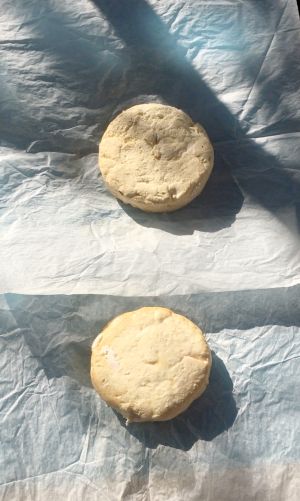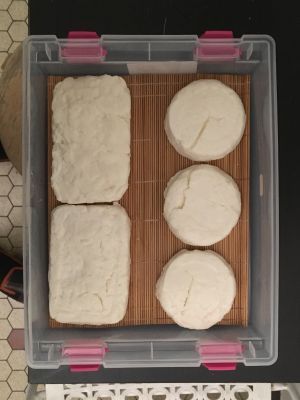Cheese production archives: Difference between revisions
| Line 42: | Line 42: | ||
! Milk origin !! Milk processing and curdling !! Starter !! Molding !! Ripening time and process | ! Milk origin !! Milk processing and curdling !! Starter !! Molding !! Ripening time and process | ||
|- | |- | ||
| /. || /. || No lactic ferments nor starter culture. || | | /. || /. || No lactic ferments nor starter culture. || Medium plastic molds from <i>faisselle</i> yogurt, where the cheeses spent 1 day without being pressed. || <br/>- 3 days outside in molds (covered with net). <br/>- 18 days of ripening in fridge. | ||
|} | |} | ||
<gallery mode="traditional"> | <gallery mode="traditional"> | ||
| Line 56: | Line 56: | ||
! Milk origin !! Milk processing and curdling !! Starter !! Molding !! Ripening time and process | ! Milk origin !! Milk processing and curdling !! Starter !! Molding !! Ripening time and process | ||
|- | |- | ||
| Beans grown in Europe: cooked, hulled and mashed for white and red; heated milk for soja. || Cider vinegar from France. || No lactic ferments nor starter culture. || Small <i>faisselle</i> yogurt | | Beans grown in Europe: cooked, hulled and mashed for white and red; heated milk for soja. || Cider vinegar from France. || No lactic ferments nor starter culture. || Small plastic molds from <i>faisselle</i> yogurt, where the cheeses spent a few days without being pressed. || - First tasting after 3 days outside in molds (covered with net). <br/>- Second tasting after 18 days of ripening in fridge. | ||
|} | |} | ||
====Hypothesis==== | ====Hypothesis==== | ||
| Line 72: | Line 72: | ||
! Milk origin !! Milk processing and curdling !! Starter !! Molding !! Ripening time and process | ! Milk origin !! Milk processing and curdling !! Starter !! Molding !! Ripening time and process | ||
|- | |- | ||
| Cow full milk, unpasteurised, provided by Farm of Ondet corner, in the mountains of Mont-Dore, France. || Cider vinegar from France. || No lactic ferments nor starter culture. Cooked and mashed potatoes was added to the cheese. || Small <i>faisselle</i> yogurt | | Cow full milk, unpasteurised, provided by Farm of Ondet corner, in the mountains of Mont-Dore, France. || Cider vinegar from France. || No lactic ferments nor starter culture. Cooked and mashed potatoes was added to the cheese. || Small plastic molds from <i>faisselle</i> yogurt, where the cheeses spent a few days without being pressed. || - First tasting after 3 days outside in molds (covered with net). <br/>- Second tasting after 18 days of ripening in fridge. | ||
|} | |} | ||
====Hypothesis==== | ====Hypothesis==== | ||
Revision as of 11:27, 19 January 2021
September 2019 | Normandie smoked cheese in Paris
Rygeost cheeses
| Milk origin | Milk processing and curdling | Starter | Molding | Ripening time and process |
|---|---|---|---|---|
| Normandie full cow milk, unpasteurized. | Powdered animal rennet in re-heated milk, 24h curdling. | No lactic ferments nor starter culture. | Homemade mold from drilled plastic containers where the cheeses spent a few days without being pressed. | - Turned daily the first week. - days outside in aerated box before dry salting on both faces. - 4 days in fridge before smoking for 1 hour with hay. - Kept in fridge 1 more week before serving (2 months for extra batch). |
This cheese recipe was inspired by a Danish smoked cheese called Rygeost. It is crucial to let the cheese rest at least one week after smoking, so that the burnt taste does not take over on the freshness of the soft cheese taste. The cheese should not be over-ripen, but it can be kept in the fridge for 2 weeks as the smoke prevents mold to develop on its rind. 2 batches of this cheese were made in Paris before to be served in Amsterdam on the 4th of October for a performance dinner called The Soft Protest, re-chewing & Digest. A third batch was kept unsmoked and ripen for 2 month.
- Error creating thumbnail: File missing
- Error creating thumbnail: File missing
- Error creating thumbnail: File missing
- Error creating thumbnail: File missing
February 2020 | Vexin cheeses in Paris
Soft blue cheese attempt
| Milk origin | Milk processing and curdling | Starter | Molding | Ripening time and process |
|---|---|---|---|---|
| Vexin full cow milk, unpasteurized. (Sourced from Laiterie de la Chapelle, Paris.) | Powdered animal rennet in re-heated milk, 24h curdling. | No lactic ferments. Attempt of starter culture transplantation from blue cheese (Penicillium roqueforti) on the squarish ones. | Homemade mold from drilled plastic containers where the cheeses spent a few days without being pressed. | - Turned daily the first week. - 3 days outside in aerated box before dry salting on both faces. - Sealed in aluminium paper. - 1 month ripening in fridge for 1 round sample. 3 months for the others. |
On the round ones, no small organism culture of any kind was added. The squarish ones saw their milk curdle with Penicillium roqueforti in it (bits of Bleu d'Auvergne AOC cheese in the milk). After being forgotten during the covid19 lockdown in France for 3 months, they gave the most unexpected results. Despite the aluminium paper in which they were sealed, the humid environment led mold develop itself to a much too large extent. As a result, the over-ripen round samples turned out to taste even more “blue-cheese-like” than the squarish ones. Furthermore, none of them develop the expected blue veins but rather spots of unwanted dark mold. On the positive side, both had a grainy/smooth texture akin to Roquefort cheese. Their smell and taste was strong but deliciously tart.
- Error creating thumbnail: File missing
- Error creating thumbnail: File missing
- Vexin-cheeses ripen 2.jpg
- Error creating thumbnail: File missing
April-May 2020 | Mont-Dore and experimental cheeses in La Bourboule
Mont-Dore cheeses
| Milk origin | Milk processing and curdling | Starter | Molding | Ripening time and process |
|---|---|---|---|---|
| /. | /. | No lactic ferments nor starter culture. | Medium plastic molds from faisselle yogurt, where the cheeses spent 1 day without being pressed. | - 3 days outside in molds (covered with net). - 18 days of ripening in fridge. |
- .jpg
- .jpg
For the following cheeses, we initiated a quest for types of “cheeses” that could help reducing milk consumption and intensive milk-farms in regions where the landscape is not well-suited for having cows on grass, in landscapes with less sun where beans would thrive, or in sandy, loamy and rocky soils which makes beans quite resilient.
Bean-cheeses
| Milk origin | Milk processing and curdling | Starter | Molding | Ripening time and process |
|---|---|---|---|---|
| Beans grown in Europe: cooked, hulled and mashed for white and red; heated milk for soja. | Cider vinegar from France. | No lactic ferments nor starter culture. | Small plastic molds from faisselle yogurt, where the cheeses spent a few days without being pressed. | - First tasting after 3 days outside in molds (covered with net). - Second tasting after 18 days of ripening in fridge. |
Hypothesis
The first experiment, “bean-cheese”, is meant to allow cheesemakers to swipe dairy-cheese for vegetal-cheese with the same tools and fungi they use. Thus, they could adapt in time of drought, and benefit from that possible vegetal asset which could attract a different customer (lactose intolerant/vegans) base to their cheesemaking business. As beans (such as soja) have an amazing diversity and can be grown all around the world and dried, each vegetal cheese can be as rooted in its region as the actual cheeses are, with their own microflora and ripening time (like different tofus in China).
Results
The“bean-cheeses” using soja were inspired by “stinky tofu” recipes, but this method turned inefficient when applied to other types of beans (red & white). We did not find any appropriate way to curdle the milk, and focused on bean paste. The taste was strongly vegetal before ripening, and uneatable after 2 weeks — while matured tofu developed strong cheese-like notes.
- .jpg
- .jpg
Potato-cheeses
| Milk origin | Milk processing and curdling | Starter | Molding | Ripening time and process |
|---|---|---|---|---|
| Cow full milk, unpasteurised, provided by Farm of Ondet corner, in the mountains of Mont-Dore, France. | Cider vinegar from France. | No lactic ferments nor starter culture. Cooked and mashed potatoes was added to the cheese. | Small plastic molds from faisselle yogurt, where the cheeses spent a few days without being pressed. | - First tasting after 3 days outside in molds (covered with net). - Second tasting after 18 days of ripening in fridge. |
Hypothesis
The second —yet unsuccessful— experiment, explores how “potato-cheeses” could be an interesting way to lower pressure on grasslands or imported feed in times of drought, by using 1/4 to 1/2 less milk per cheese produced. While reading about potatoes for various projects, we came across an experiment made by a German cheesemaker, who tried to create cheeses made of mashed potatoes matured with curd (preferably goat or sheep milk). French scholar Louis de Jaucourt, the most prolific contributor to the first Encyclopedia (XVIIIth century), wrote that the share of milk and potatoes could differ depending on customers wealth: the wealthier the milkier.(We repeated the “potato-cheese” process with tofu to give it a try.)
Results
The “potato-cheeses” taste was close to so-called Aligot (a french specialty from Auvergne region) in the first days, and turned to a running paste in the long run, but the 2 weeks matured potato brought strong amonia notes that made it uneatable.
- .jpg
- .jpg

